Heel Spurs
Heel Spurs are also known as Calcaneal Spurs, Osteophytes, Pump Bump, Exostosis of the Heel, Heel Spur Syndrome.
What Is A Heel Spur?
When the body is under stress or constant inflammation it will deposit calcium to our bones. This added 'bone growth' is designed to relieve the added stress/pressure to our connective tissue.
A heel spur will often result from excess stress being placed on fascia in the foot; to counter this stress, the body adds calcium to the bottom underside of the heel bone where the plantar fascia attaches, growing in the direction of the toes. This abnormal growth of bone forms over a period of many months and the growth itself can reach a length of up to 1/2 inch long.
Heel bones vary in shape and size from person to person and an irregular shaped heel can often cause the Plantar ligament or Achilles tendon to twist. Also, the smaller the heel bone, the greater the stress put on tendons and ligaments (as they are attached at smaller points.
Extra tension can result in overstretching, inflammation and/or micro-tearing of the plantar fascia, strains on the foot muscles and ligaments, and repeated tearing of the membrane that covers the heel bone. As your body tries to heal itself, the heel spur forms from calcium deposits (osteophytes) at the bottom of your heel. It can vary in shape from a flat, shelf-like growth to a hook-shaped, pointy projection, and can extend forward up to a half inch. Your body grows this extra bone and tissue with the intent to help relieve pressure on the plantar fascia.
How Many People Have Heel Spurs?
Estimates of the percentage of the population with heel spurs range between 10% to 21%. Heel Spurs are most often seen in athletes, people who are on their feet all day, are overweight, and/or over 40 years of age. Only around 5% of people with heel spurs complain of pain. Like we've mentioned before, your feet work hard and it makes sense that wear and tear has impact over time. This can present itself in a number of different ways.
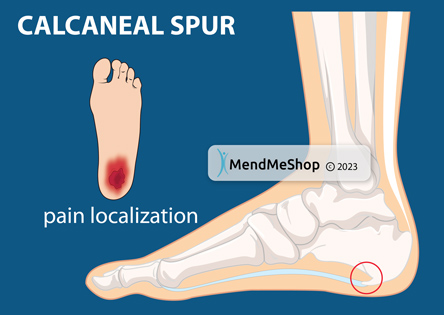
The heel bone (aka calcaneus) is located in the back of the foot, beneath the arch. It’s shaped like an arrowhead and connects to the Achilles tendon at the back of the ankle. The spur itself is not painful, however, if it is sharp and pointed it can poke into soft tissue surrounding the spur itself. As the bone spur irritates the tissue, inflammation and bruising can occur leading to heel pain.
Heel spurs can affect your ability to do your usual work and/or activities, and can also trap and irritate nerves in the heel area. They can change the way you walk, and can lead to knee, hip and low back injuries. If severe, they may require medical intervention.
A heel spur is bony protrusion on the underside of the heel bone caused by an increase in calcium deposits.
Many people refer to plantar fasciitis and heel spurs as one in the same. Although these are similar, they are not the same. Heel spurs can actually be caused by plantar fasciitis; 50% of people with plantar fasciitis have heel spurs, whereas 19% of people with heel spurs do not have plantar fasciitis.
What Is The Difference Between A Heel Spur & Plantar Fasciitis?
Plantar fasciitis is often caused by a tight or strained plantar fascia ligament that runs from your toes to your heel. This can cause pain in the heel area, especially when stressing the foot after resting for long periods. (ie. getting out of bed in the morning). A heel spur is bony protrusion on the underside of the heel bone caused by an increase in calcium deposits. Heel spurs can also cause pain in the heel, generally due to inflammation and irritation caused by the spur poking surrounding tissue in the area.
However, there is a link between Heel Spurs and Plantar Fasciitis. A heel spur can occur because of Plantar Fasciitis. The damage to the Plantar Fascia that causes inflammation (and pain) can trigger the formation of a heel spur. The body sometimes responds to stress (ie. fascia tearing that leads to plantar fasciitis) by creating a barrier out of bone which in this case, would be the formation over time, of a heel spur.
What Can Cause a Heel Spur?
There is no single cause for Heel Spurs, though as mentioned previously, heel spurs will often occur in someone suffering from plantar fasciitis (50% of Plantar Fasciitis suffers have heel spurs). To a significant degree, you can assume that some causes of Heel Spurs (HS) are also causes of Plantar Fasciitis (PF). There is also a strong correlation between HS/PF and underlying diseases that cause arthritis (inflammation of the joints) such as Ankylosing Spondylitis (a form of arthritis featuring chronic inflammation of the spine and sacroiliac joints) and Reactive Arthritis (inflammation of the joints due to an infection in another part of the body).
Faulty Foot Structure
Faulty foot structures are known to cause heel spurs. Most common faulty structures are:
- Differing Leg Lengths (aka short leg syndrome)
Differing leg lengths affect the way you walk (gait); often the change in gait will result in excessive, repetitive force in the foot, knee and/or hips. Too much pressure on the heel or ball of the foot results in plantar fasciitis, heel spurs or other foot-related soft tissue injuries. - Unhealed Injuries (ie. foot tendinitis, plantar fasciitis)
- Flat Feet (Overpronation of the Foot)
Flat feet can be hereditary or develop later on due to various reasons that involve over-abuse of the foot (weak foot muscles, heavy foot strain, aging, excessive time spent standing/walking, or wearing improper shoes). If you have flat feet, you probably endure significant arch pain and walk with an overpronated gait (more weight put on the inside portion of the foot). As the arch of the foot drops, more stress is put on tendons and ligaments that support the arch and pain will increase. If you suffer from flat feet you are more likely to start developing not only heel spurs, but back and hip pain as well as increased chances of ankle sprains. - High Arches
As with flat feet, if you have high arches, you are also more likely to develop Heel Spurs (and Plantar Fasciitis). High Arches are most common in women due to the popularity of high-heel shoes and shoes with high arches. The pressure from the high arch in the shoe exerts added pressure on the plantar ligament, especially at the point where it meets the heel. This added pressure will increase the probability of bone spur growth in the heel. - Muscle Imbalances
Muscle Imbalances - almost anywhere in the body - can and will result in an unbalanced gait. As mentioned before, an unbalanced gait will exert excess pressure on some areas of the foot (and often knee and hip); it is this excess pressure on either the ball of the foot or the heel that can easily initiate the growth of a heel spur. The odds of this happening increase over time - for chronic muscle imbalances that affect gait, you will likely end up with tendinitis in the foot, plantar fasciitis and/or heel spurs.
Muscle imbalances is a term that could mean many things. Typically a muscle imbalance is due to tight, weak or shortened muscles. This is most often the result of an injury, chronic disease or overcompensation from another injury.
Poor Bio-Mechanics
Poor biomechanics affect the way your foot hits the ground. If you overpronate (feet roll inward) you tend to have flat feet (pes planus), which increases stress on the heel bone.
Regular shoes or high heels that are too tight or don't support your heel or arch affect the distribution of your body weight on your foot
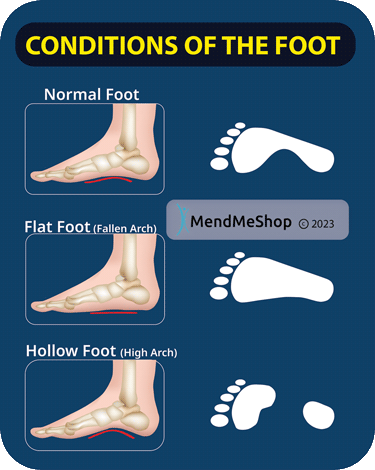
Heel Fat Pad Syndrome
"Heel fad pad syndrome is the thinning of the fat pad that supports and cushions your heel. It’s a painful condition."[1] Fat pad thinning at the heel can happen due to:
- you wear shoes with poor arch support for too long without giving them time to rest between wearing
- excessive walking
- wearing shoes that are too tight or do not fit properly
- arthritis in the joints around the heel
Health Conditions
Health conditions such as obesity, inflammatory diseases (rheumatoid arthritis, ankylosing spondylitis), bursitis, neuroma (nerve growths), gout, diabetes, Haglund's deformity, and Achilles tendinitis can also instigate heel spurs.
Other
If you are running or jogging on hard surfaces, especially without adequate shoe cushioning, your risk of developing heel spurs is high. Also, repetitive striking of the heel bone (ie. stomping on something with your heel) will provoke a heel spur response due to over-stressing of the heel.
Heel Spur Symptoms
You may or may not experience any symptoms to indicate you have a heel spur. It is normally discomfort due to irritation and inflammation felt in tissues around the heel spur that will alert you to the problem.
How Do You Know If You Have a Heel Spur?
Pain
To put it simply, you'll feel pain in your heel when you're walking, running or standing. It may also hurt when putting on shoes, walking up or down stairs and bending your foot. The pain can worsen if you stand on a hard surface such as concrete for an extended period of time. You may encounter heel pain when pushing off the ball of your foot (this stretches the plantar fascia). The pain can get worse over time and tends to be stronger in the morning, subsiding throughout the day; although it does return with increased activity.
You may feel a sharp, 'knife-like' pain, as you wake and take your first step in the morning.
You may feel a sharp, poking pain in your heel that feels like you're stepping on a stone; often this is felt while standing or walking. You will sometimes be able to feel a bump on the bottom of your heel, and occasionally bruising may appear.
Swelling & Tenderness
As you would likely expect, heel spur irritation will manifest as swelling and tenderness in and around the bottom of the heel; with the swelling, the area will also likely feel 'hot'.
Diagnosing Heel Spurs
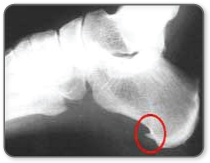
If your foot pain is persistent, consider making an appointment with a podiatrist. A podiatrist is a doctor who specializes in the study and treatment of disorders of the foot and ankle. They’re also known as "foot and ankle surgeons". A podiatrist can help you with heel pain, plantar fasciitis and other foot problems. Your family doctor or general practitioner may refer you to a podiatrist if they feel that surgery is appropriate for your condition.
Your doctor will discuss your medical history and will examine your foot and heel for any deformities and inflammation (swelling, redness, heat, pain). He/she will analyze your flexibility, stability, and gait (the way you walk). Occasionally an x-ray or blood tests (to rule out diseases or infections) may be requested.
A Note On OverCompensation
Since you have read up to this point, you probably realize that serious foot pain will eventually wreak havoc on you due to lack of movement and over-compensation. It will also create trouble in other joints and muscles due to overcompensation. Recovery takes a longer time for such chronic (long term) injuries, but proper healing is essential to regain strength and get you back to the activities you enjoy.
The longer your injury endures, the greater the risk of running into serious overcompensation injuries.
To Stop Re-Injury & Reduce the Risk of a More Serious Overcompensation Injury, You Need to Heal Quickly & Completely!
Anyone in need of rapid recovery and complete healing must consider a comprehensive treatment plan that includes an effective means to minimize swelling and inflammation yet also stimulate healing and tissue elasticity. We have found no better set of tools that can be used at home than this:
Conservative Treatment Tools Our Clients Have Used to Help Limit Foot Damage & Boost The Body's Soft Tissue Repair Process at Home:
If you are truly looking for the home treatment options to reduce inflammation, increase range of motion, and treat the source of pain quickly, a conservative treatment protocol including the following are what we consider to be the most effective:
- A Cold Compress or Ice Pack to reduce inflammation wherever there is pain and/or swelling (as soon as possible).
- A Plantar TShellz Wrap® [or a Sesamoid TShellz Wrap® if the location is at the metacarpals or toes] to increase blood-flow to the targeted treatment area (a Localized Enhanced Circulatory Response® Treatment).
- MendMeShop Arnica Pain Cream for powerful, temporary relief of pain due to sore muscles and joints.
- Perhaps a High Quality Knee Pillow for comfort while sleeping, sitting and raising the foot.
- If you need compression, a Plantar Compression Band for compression and support in the foot - adjustable from heel to toe.
- An Exercise & Stretching Plan to prevent muscle atrophy, shortened tendons/ligaments/fascia. A proper plan will increase soft tissue elasticity and strength in the affected area.
Conservative treatment tools just like these have been used successfully by thousands of foot injury sufferers - just like you.
The TShellz Wrap®: Intended to Enhance Blood Flow in the Treatment Area
We believe the use of TShellz Wraps® for boosting blood flow to soft tissue in the area of application is one of the most under-utilized home treatment options available on the market today. We have client after client that have tried many options out there and have been amazed at how effective and fast the TShellz Wrap® treatment has helped in their recovery.
Increased Blood Flow Stimulates the Bodys' Ability to Heal
With regular use of the Plantar, Sesamoid and/or Achilles TShellz® Circulatory Boost Wrap:
- Your pain will be reduced*.
- Due to increased blood flow, soft tissue in the treatment area on the foot will be expected to recover at an accelerated rate with reduced potential for re-injury*.
- Tissue in the treated area should experience a larger range of motion and increased extensibility of collagen tissue* due to the heat effect on soft tissue. This should translate into a reduced rate of re-injury occurrence as soft tissue is known to lengthen and become more flexible when exposed to warm temperature. (*Chapter 9 of "Therapeutic Heat and Cold", 4th edition. - Ed. Justus F. Lehmann, M.D., Williams, and Wilkin)
*Know that every personal soft tissue injury is unique and the TShellz Wrap may not work for everyone. This is why we offer a 60-day money back return on all our TShellz Wrap devices.

4 Key Points To Keep in Mind When Treating Plantar Fasciitis & Other Connective Tissue Injuries in the Foot
1: Make Sure That Complete Healing is Your #1 Goal
We all know that if the injury was healed, the pain would go away but what about the opposite situation? If the pain is gone, does that mean the injury is better? Unfortunately, this is not always true.

Too many people only focus on suppressing pain symptoms while providing less attention to the true healing aspects of the body. Experiencing less pain, while obviously a good short-term goal, never equates to underlying healing. Scar tissue can remain for months after one gets to a point of being relatively pain-free. However, as long the weak and brittle scar tissue remains, you are susceptible to re-injury or re-aggravation. Certain motions or movements can cause weaker tissue to easily tear - resulting in some reversal of the recovery up until that point.
This is why we recommend for people to continue with their doctor or therapist recommended exercises and to continue with mild treatments of the TShellz Wrap® for a period of time - to better ensure complete healing.
Ongoing treatments to enhance circulation are intended to soothe, relax and promote healing of damaged soft tissue in the application area. T•Shellz treatment also results in the ability of soft tissue to extend further due to the effect of heat on soft tissue. The more extensible your tissues are, the less likely they are to strain or sprain.
Soft tissue injuries are a race against time. The faster and stronger you heal tissue in your foot, the less chance there is for re-injury or other problems later on.
2: Resting Your Feet Will Help, But Only Temporarily
People tell us all the time, "I was told that if I rest for a few weeks, the pain will disappear for good." The truth is, pain is often a culmination of numerous factors, which often include repetitive stress, high load issues due to excess weight, and/or overcompensation issues resulting from other muscle and soft tissue ailments (ie. short leg syndrome). It may take weeks or months for these pain triggers to surface, but when they do, merely resting will not solve the underlying issues. You need to utilize options that actually treat the source of the pain and help reverse the damage that has been done.
Resting has a role to play, but it is only one small factor in a recovery plan.
3: Determine if There is A Deeper Underlying Cause To Your Problem & Fix It. Otherwise, It May Come Back
In order to get lasting relief, you need to identify all the factors that are contributing to your foot pain. An example of some factors that may or may not be relevant are:
- muscle imbalances
- pinched nerve(s) in the knee, ankle, hip or lower back
- short leg syndrome
- obesity
- flat footedness
- trauma
4: Know that Pain isn't the Only Proof You're Still Injured

Would you know you injured yourself if there was no pain? Probably not! Pain and swelling perform a useful role in letting you know that you did, in fact, injure yourself. Pain and swelling are what get you to seek out medical attention in the hopes of finding a way to reduce the pain and heal your injury.
Plantar fasciitis (PF) will likely cause extreme pain and according to studies, it is an indicator of chronic morbidity [meaning that PF is a statistical predictor of long term foot problems]. Be careful with pain-killers that mask the pain as overuse can give you a false sense that your injury is gone. Strive to reduce the inflammation and maintain or improve flexibility in the foot while avoiding re-injury to see a reduction in pain.
On-going TShellz Wrap® treatments at home, every day, are intended soothe, relax and promote blood flow to soft tissue. Consistent TShellz® Circulatory Boost Wrap treatments before activity or work will help warm up the area, increasing soft tissue elasticity & flexibility; this in turn will also reduce the risk of re-injury.
New Technology For The Best Therapy Available!
TShellz Wraps® are what we believe to be the most highly effective home medical devices out there - helping boost blood circulation, increase elasticity of soft tissue, reduce inflammation and minimize pain. It is a product we have developed specifically for this purpose. You can be certain it will do this, as we give full refunds if this is not the case.
The Energy Pad stimulates all the tissue beneath it evenly. The parts of your body that are healthy will rapidly respond with increased blood flow and there will be little sensation in that area. As your body continues to recover you'll also notice a decrease in pain and the range of motion in your foot should slowly start to improve. So not only does pain and inflammation go away, but with every treatment you can feel the difference - you can tell your injury is getting better.
TShellz Wraps®: Comfortable, Effective and Easy To Use
- TShellz Wraps® are very comfortable to wear. The shell is soft and very flexible. The edges are soft and will not irritate your skin.
- The Energy Pad within is also flexible like cloth so the entire unit conforms to your body.
- TShellz Wraps® are cut and sewn specifically to fit each part of the body so they fit comfortably. They come with velcro closures and are very easy to put on and take off.
- It is so easy to plug and un-plug you can stop and start your treatments with ease. This wrap is comfortable enough to wear all day long.
- The TShellz Wrap® is not affected by clothing. Wear it over or under - it is up to you.
TShellz Wraps® - Premium Quality, 100% Guaranteed!
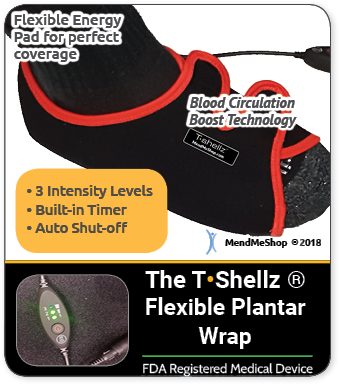
Like all our products, TShellz Wraps® are high quality wraps you will find nowhere else. We have them for every part of the body. And, of course, we guarantee our wraps with the MendMeShop 60 day, money back guarantee. If you are not finding any improvement after using our TShellz product over a 60 day period, contact us for a full refund. We also provide a full year warranty on our TShellz Wrap® devices.
So, if you're really looking for an effective home therapy to treat torn or strained connective tissue; if you're looking to reduce inflammation, treat scar tissue, boost blood circulation and strengthen soft tissue, the TShellz Wrap® is what we recommend. We feel it is an exceptional home based approach to maximizing your soft tissue injury recovery process.
AidMyPlantar is committed to bringing you quality products for helping you relieve pain and boost blood flow to maximize your home recovery. These products are quickly revolutionizing the way the therapeutic industry thinks about soft tissue treatments and come highly recommended by our customers. If you have injured soft tissue that you want to deal with quickly, harness the power of your own body to heal itself and boost blood flow to the area, accelerating the body's own healing bio-mechanism.
Post Surgery Recovery
For Post-Surgery Recovery, cold is recommended by doctors to treat pain and swelling in a natural, non-addictive way.
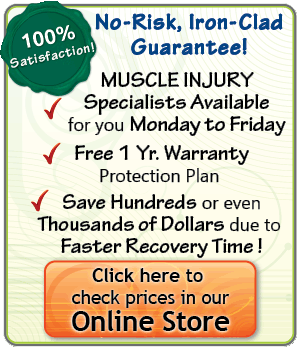
After the incision site has healed, use our TShellz Wrap® home treatments to stimulate blood flow in the area. Using the TShellz Wrap® as soon as pain & swelling has reduced following your surgery will help minimize scar tissue growth that forms in soft tissue at the surgery site as you heal. Treating scar tissue is often one of the most important steps following surgery, especially the more invasive surgeries as they typically result in high growth levels of scar tissue. This is also why you should never skip phyical therapy appointments - their primary goal is to get you limber - much of the work in physical therapy is to break up scar tissue and get you mobile again; physical therapy is a crucial component in the recovery process.
Leaving post-surgery scar tissue untreated can lead to stiffness, chronic pain, osteoarthritis or other chronic conditions. You're more likely to end up with another injury if you choose not to deal with the scar tissue that develops in your soft tissue - this is why pretty much all post surgery recoveries involve physical therapy. The TShellz® Circulatory Boost Wrap encourages more oxygen and nutrients to flow to the area to help your body in its recovery process. An increase in blood flow should also help improve the strength of soft tissue in the area.
Our Formula is Proven to Work!
We are very confident our T•Shellz home therapy products will assist you in recovering from your injury by reducing your swelling and inflammation induced pain, maximizing blood flow where it's needed most and increasing the flexibility, range of motion in the area.
Here at AidMyPlantar we pride ourselves in helping you with your healing and recovery process. Everyone at AidMyPlantar has tested and used the products. Dedication to our customers and our products goes hand-in-hand with our guarantees to you as a customer:
- Guarantee #1 - Use your products diligently for up to 60 days and you will experience a significant reduction in pain. If not, I encourage you to send back the items for a 100% refund.
- Guarantee #2 - You will not be left in the dark after purchasing any products from us. AidMyPlantar Advisers and Product Specialists are available 7 days a week by toll free phone 1-866-237-9608 or email to answer your questions or concerns.
- Guarantee #3 - Your order is guaranteed to be shipped within 24 hours on every business day.
- Guarantee #4 - All purchases receive a one year, full replacement warranty with guaranteed, prompt service.
- Guarantee #5 - You could save hundreds of dollars and possibly more, by utilizing our products, and getting back to work sooner.
Yes, they are that good. See for yourself.
The TShellz Wraps® are FDA Registered Medical Devices, and are suitable for use in therapeutic clinics. Since they are completely safe for patients to use themselves as instructed, they are now available for use at home.
Once treatment is complete, you also have the option of tightening the straps to provide light compression support for your injured joint. You can also unplug the device from the power supply enabling you to move around the home, office or clinic freely and still use the wrap for support and comfort.
Product specialists are available 9:00 am to 5:00 pm Eastern Standard Time Monday to Friday.
If any question or concern arises, call us or simply send us an email at any time (we check our emails constantly all throughout the day and night.. even on holidays!). We will respond as soon as possible.
North America Toll Free 1-866-237-9608
Outside North America +1-705-532-1671
FREE SHIPPING ON ALL PRODUCTS CURRENTLY ENABLED
Please be aware that this information is neither intended nor implied to be a substitute for professional medical advice. All testimonials and comments reflect the real life experiences of individuals that used our products, however, individual results may vary. Always seek the advice of your physician or other qualified health provider before using any of our outstanding products to make sure they are right for you and your condition or if you have any questions regarding a medical condition.
For more information, call us via: 1-866-237-9608 or send us an email. View our Privacy Policy.
The terms Inferno Wrap®, Freezie Wrap®, T-Shellz® and Mendmeshop.com® are registered trademarks of In.Genu Design Group Inc.
All images shown are exclusive Copyright© 2006 - 2025 AidMyPlantar.com.
Sources:
1. Reducing Heel Pad. (2023) Heel Fat Pad Syndrome: Symptoms, Causes & Treatment. Retrieved April 13, 2023, from https://my.clevelandclinic.org/health/diseases/23275-heel-fat-pad-syndrome